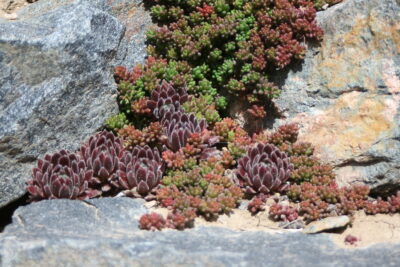
Growing Blue Bean Succulents: A Guide for Home Gardeners

The world of succulents is vast and diverse, offering a wide range of unique and captivating plants for home gardeners to enjoy. One such plant that has gained popularity in recent years is the blue bean succulent. With its striking blue-green foliage and intriguing bean-like shape, this succulent has become a favorite among plant enthusiasts. But growing blue bean succulents can be a bit challenging, requiring specific care and attention. We will explore the world of blue bean succulents, providing a comprehensive guide for home gardeners who are interested in growing and caring for these stunning plants.
We will start by delving into the characteristics and origins of blue bean succulents, exploring their unique features that set them apart from other succulent varieties. We will then discuss the ideal growing conditions for blue bean succulents, including light, temperature, and watering requirements. Additionally, we will provide step-by-step instructions on propagating blue bean succulents, as well as tips for repotting and maintaining their overall health. By the end of this article, home gardeners will have a solid understanding of how to successfully grow and care for blue bean succulents, allowing them to enjoy the beauty and uniqueness of these eye-catching plants in their own gardens.
- Provide succulents with well-draining soil to prevent root rot
- Water succulents sparingly, allowing the soil to dry out between waterings
- Place succulents in a sunny location to promote healthy growth
- Fertilize succulents with a balanced fertilizer during the growing season
- Protect succulents from frost and extreme temperatures by bringing them indoors
- Prune succulents to maintain their desired shape and promote bushier growth
- Propagate succulents by taking stem or leaf cuttings and allowing them to root
- Monitor succulents for pests and treat infestations promptly
- Replant succulents in larger containers as they outgrow their current pots
- Enjoy the unique and beautiful blue color of blue bean succulents in your garden
- Frequently Asked Questions
Provide succulents with well-draining soil to prevent root rot
Succulents, including blue bean succulents, thrive in well-draining soil. It is crucial to provide them with the right growing medium to prevent root rot. Root rot occurs when the roots of plants are constantly exposed to excessive moisture, leading to decay and eventual death of the plant.
To ensure proper soil drainage, it is recommended to use a combination of sandy and gritty soil. This type of soil allows excess water to flow through, preventing waterlogged conditions that can be detrimental to the health of your blue bean succulents.
When selecting a potting mix, look for one specifically designed for succulents or cacti. These mixes usually contain a high percentage of sand or perlite, promoting excellent drainage. Avoid using regular potting soil, as it tends to retain moisture, increasing the risk of root rot.
Additionally, adding a layer of gravel or small rocks at the bottom of the pot can further enhance drainage. This layer acts as a barrier, preventing the roots from sitting in water and promoting airflow within the soil.
 Planting Succulent Cuttings: Skip Rooting Process and See Results
Planting Succulent Cuttings: Skip Rooting Process and See ResultsRemember to water your blue bean succulents only when the soil is completely dry. Overwatering is one of the most common causes of root rot in succulents. Wait until the top inch of soil feels dry before watering, and ensure that excess water drains out of the pot completely.
By providing your blue bean succulents with well-draining soil and taking care not to overwater, you can ensure their optimal growth and prevent the risk of root rot.
Water succulents sparingly, allowing the soil to dry out between waterings
One of the most important things to remember when growing blue bean succulents is to water them sparingly. These plants have adapted to arid conditions and are capable of storing water in their leaves, stems, and roots.
It is crucial to allow the soil to dry out between waterings to prevent overwatering, which can lead to root rot and other diseases. Depending on the climate and the specific needs of your blue bean succulents, you may only need to water them once every two to three weeks.
When watering, make sure to thoroughly soak the soil until water drains out from the bottom of the pot. This will ensure that the roots receive enough moisture without becoming waterlogged. However, it's essential not to leave the plants sitting in standing water, as this can also lead to root rot.
Keep in mind that the frequency of watering may vary depending on factors such as the size of the pot, the type of soil, and the amount of sunlight the plant receives. Always monitor the moisture levels of the soil and adjust your watering schedule accordingly.
 Fast-track Succulent Propagation: Tips for Accelerated Growth
Fast-track Succulent Propagation: Tips for Accelerated GrowthRemember, it's better to underwater than overwater your blue bean succulents. These plants are incredibly resilient and can tolerate periods of drought. In fact, they thrive in dry conditions, so it's best to err on the side of caution when it comes to watering.
By following these watering guidelines, you can ensure the health and longevity of your blue bean succulents and enjoy their vibrant blue foliage for years to come.
Place succulents in a sunny location to promote healthy growth
Succulents, including blue bean succulents, thrive in sunny locations. When choosing a spot for your blue bean succulents, look for an area that receives at least six hours of direct sunlight per day. This will ensure that your succulents receive the necessary light to promote healthy growth and vibrant color.
Succulents are adapted to survive in arid conditions, so they are well-suited for outdoor gardens or indoor spaces that receive ample sunlight. If you're growing blue bean succulents indoors, place them near a south-facing window or use artificial grow lights to provide the necessary light.
When positioning your succulents, be mindful of any potential obstructions that could block sunlight. Avoid placing them near tall trees or buildings that may cast shadows over your plants for prolonged periods.
Remember that succulents can also tolerate some shade, but they may not exhibit their full potential for color and growth in low-light conditions. If you're unsure about the lighting requirements of your blue bean succulents, consult the care instructions specific to your plant variety.
Providing well-draining soil is crucial for blue bean succulents
One of the most important factors in successfully growing blue bean succulents is providing well-draining soil. Succulents, including blue bean varieties, are native to desert environments where water is scarce. Therefore, they have adapted to store water in their leaves and require soil that allows excess moisture to drain quickly.
 Propagating Split Rocks Succulents: Can They Be Divided for Growth?
Propagating Split Rocks Succulents: Can They Be Divided for Growth?To create well-draining soil for your blue bean succulents, you can either purchase a specialized succulent potting mix or make your own by combining regular potting soil with sand or perlite. The addition of these materials will help improve drainage and prevent waterlogged roots, which can lead to root rot and other diseases.
When planting your blue bean succulents, make sure to choose a pot or container with drainage holes at the bottom. This will allow excess water to escape and prevent the soil from becoming too saturated. Alternatively, if you're planting your succulents directly in the ground, ensure that the soil is loose and well-draining to avoid water retention.
Overall, providing well-draining soil is crucial for the health and survival of your blue bean succulents. It will help prevent overwatering and ensure that your plants receive the right balance of moisture and oxygen.
Fertilize succulents with a balanced fertilizer during the growing season
When it comes to growing blue bean succulents, one important aspect to consider is fertilization. Providing your plants with the right nutrients during the growing season can help ensure healthy growth and vibrant coloration. A balanced fertilizer is ideal for succulents, as it contains equal amounts of nitrogen (N), phosphorus (P), and potassium (K).
Before applying any fertilizer, it's essential to understand the specific needs of your blue bean succulents. Generally, these plants thrive in well-draining soil, so it's crucial to choose a fertilizer that won't retain excessive moisture. Look for a slow-release fertilizer designed for succulents or cacti, as it will provide a steady supply of nutrients over an extended period.
When applying the fertilizer, follow the instructions provided on the packaging. In most cases, it's best to dilute the fertilizer with water to prevent over-fertilization, which can be detrimental to the plant's health. Apply the diluted fertilizer mixture to the soil around the base of the succulent, ensuring that it reaches the roots.
 Step-by-Step Guide: Growing a Beautiful Rose Succulent
Step-by-Step Guide: Growing a Beautiful Rose SucculentDuring the growing season, which typically spans spring and summer, feed your blue bean succulents with the balanced fertilizer once every two to four weeks. This schedule will provide the plants with a consistent supply of nutrients to support their growth and development.
Pro tip: When fertilizing succulents, it's crucial to avoid fertilizing during their dormant period, which usually occurs during the fall and winter months. During this time, succulents require less water and nutrients, so it's best to refrain from fertilizing to prevent potential damage.
Protect succulents from frost and extreme temperatures by bringing them indoors
One of the biggest challenges for home gardeners growing blue bean succulents is protecting them from frost and extreme temperatures. These delicate plants are highly sensitive to cold weather conditions, which can cause irreversible damage or even death.
To ensure the survival and health of your blue bean succulents, it is crucial to bring them indoors during the winter months or when temperatures drop significantly. The controlled environment inside your home will provide the necessary protection they need to thrive.
When transitioning your succulents indoors, follow these steps to ensure a smooth and successful process:
1. Choose the Right Location
Select a location inside your home that receives adequate sunlight, preferably near a south-facing window. Blue bean succulents require at least 6 hours of direct sunlight each day to maintain their vibrant blue color and overall health.
2. Adjust the Temperature and Humidity
Maintain a temperature range of 60-75°F (15-24°C) for your succulents. Avoid placing them near drafty windows or heating vents, as sudden temperature fluctuations can be detrimental to their well-being.
 Easy Guide to Propagating Jelly Bean Succulents at Home
Easy Guide to Propagating Jelly Bean Succulents at HomeMoreover, succulents thrive in dry climates. Keep the humidity levels low, around 30-40%, to prevent the formation of fungal diseases or rot.
3. Provide Adequate Drainage
Ensure your blue bean succulents are planted in well-draining containers. Choose pots with drainage holes and use a well-draining succulent soil mix to prevent waterlogging. Excess moisture can lead to root rot, which can be fatal for these plants.
4. Adjust Watering Frequency
During the winter months, reduce the watering frequency for your blue bean succulents. Allow the soil to dry out completely between waterings to prevent overwatering. Remember, succulents are adapted to survive in arid conditions, and excessive moisture can cause their roots to rot.
5. Monitor for Pests and Diseases
Keep a close eye on your succulents for any signs of pests or diseases. Indoor environments can sometimes create a favorable breeding ground for common succulent pests like mealybugs or scale insects. Regularly inspect the leaves and stems, and take immediate action if you notice any infestations.
By following these guidelines and providing the necessary care, you can successfully protect your blue bean succulents from frost and extreme temperatures. Remember, a little extra effort during the winter months will ensure the long-term health and beauty of your beloved succulents.
Prune succulents to maintain their desired shape and promote bushier growth
Pruning is an essential task when it comes to growing blue bean succulents. By pruning these plants, you can not only maintain their desired shape but also encourage bushier growth, leading to a more compact and attractive appearance.
 Discover the Succulents with Shallow Root Systems for Easy Care
Discover the Succulents with Shallow Root Systems for Easy CareWhen pruning your blue bean succulents, it is important to keep a few things in mind. First, make sure to use clean and sterilized pruning tools to prevent the spread of diseases. You can do this by wiping the blades with rubbing alcohol before and after each use. This simple step will help keep your succulents healthy and free from infections.
Start by identifying any dead, damaged, or diseased branches or leaves. These should be the first to go. Using sharp and clean pruning shears, make clean cuts just above the node or joint to encourage new growth. Avoid leaving stubs, as they can become susceptible to rot.
Next, consider the overall shape and size you want your blue bean succulents to have. If they have become leggy or stretched out, pruning can help promote a more compact and bushy growth habit. Trim back the longer stems to encourage branching and fuller growth. Remember to always cut just above a node or joint to stimulate new growth.
Furthermore, if you notice any branches or leaves that are overcrowding others or blocking sunlight, it is advisable to remove them. This will allow for better airflow and light penetration, reducing the risk of fungal diseases and ensuring that all parts of the plant receive adequate sunlight.
Lastly, after pruning your blue bean succulents, be sure to discard any pruned material properly. Do not leave it lying around, as this can attract pests and diseases. Consider composting the organic matter or disposing of it in accordance with your local waste management guidelines.
Regular pruning is crucial for maintaining the shape and promoting bushier growth of blue bean succulents. By following proper pruning techniques and keeping your tools clean, you can ensure the health and vitality of your plants, resulting in a stunning and well-maintained garden.
Propagate succulents by taking stem or leaf cuttings and allowing them to root
One of the popular ways to propagate succulents is by taking stem or leaf cuttings and allowing them to root. This method is particularly useful for propagating blue bean succulents, which are known for their beautiful blue-green foliage.
 Can You Propagate Succulents by Cutting and Replanting the Cuttings?
Can You Propagate Succulents by Cutting and Replanting the Cuttings?To start, choose a healthy blue bean succulent plant with stems or leaves that are free from damage or disease. Using a clean, sharp knife or scissors, carefully cut a stem or leaf from the parent plant. Make sure the cutting is at least 2-3 inches long for stems or has a healthy leaf intact for leaf cuttings.
Once you have your cuttings, it's important to let them callous over before planting. This helps to prevent rot and promotes successful rooting. Place the cuttings in a well-ventilated area, away from direct sunlight, and allow them to sit for about a week or until a calloused end forms.
Next, prepare a well-draining potting mix suitable for succulents. A mix consisting of equal parts perlite, coarse sand, and potting soil works well. Fill a small pot or container with the potting mix and lightly moisten it. Avoid overwatering, as succulents are prone to root rot if kept too wet.
Now it's time to plant the cuttings. For stem cuttings, simply insert the cut end into the potting mix, making sure it is firmly rooted. If you're propagating using leaf cuttings, gently press the intact leaf into the potting mix, ensuring the cut end is in contact with the soil.
Place the potted cuttings in a bright location with indirect sunlight. Avoid placing them in full sun, as this can cause sunburn and damage the delicate cuttings. Maintain a temperature between 70-80°F (21-27°C) to encourage rooting.
Water the cuttings sparingly, allowing the soil to dry out between waterings. Overwatering can lead to root rot and hinder the rooting process. After a few weeks, you should start to see signs of new growth, indicating that the cuttings have successfully rooted.
Once the cuttings have established roots and new growth, you can gradually acclimate them to brighter light conditions. This can be done by gradually exposing them to more sunlight over a period of weeks. Remember to continue monitoring the moisture levels and adjust watering accordingly.
 Can Succulents Develop New Roots from Their Stems?
Can Succulents Develop New Roots from Their Stems?Propagating blue bean succulents through stem or leaf cuttings is a rewarding method for home gardeners. With patience and proper care, you can enjoy a flourishing collection of these stunning succulents in your own garden.
Monitor succulents for pests and treat infestations promptly
Succulents are known for their resilience and low maintenance needs, but they are not immune to pests. It is essential to regularly inspect your blue bean succulents for any signs of infestation. Pests such as aphids, mealybugs, and spider mites can wreak havoc on your plants if left untreated.
When conducting a pest check, pay close attention to the leaves, stems, and soil of your succulents. Look for any visible pests, eggs, or larvae, as well as any unusual discoloration or damage. Remember that prevention is key, so it is recommended to monitor your plants even if you don't notice any immediate signs of infestation.
If you do detect pests on your blue bean succulents, it is crucial to take immediate action to avoid further damage. Here are some steps you can take to treat infestations:
- Isolate affected plants: Remove any infested plants from the vicinity of healthy ones to prevent the pests from spreading. Quarantining the affected plants also helps in focusing your treatment efforts.
- Manual removal: For larger pests like snails or slugs, you can physically remove them from your succulents. Use gloves or tweezers to carefully pick them off and dispose of them properly. This method can be time-consuming but efficient for minor infestations.
- Natural remedies: There are several organic pest control options you can try, such as neem oil, insecticidal soap, or a mixture of water and dish soap. These remedies can be effective against pests like aphids and mealybugs. Follow the instructions on the product label for the correct application method.
- Chemical treatments: If the infestation persists or becomes severe, you may need to resort to chemical treatments. However, be cautious when using pesticides and follow the instructions provided by the manufacturer. Always choose products specifically formulated for succulents to minimize any potential harm to your plants.
- Regular maintenance: After treating the infestation, it is essential to continue monitoring your succulents regularly. Inspect them for any signs of re-infestation and take prompt action if necessary. Additionally, maintaining a healthy growing environment for your plants, such as proper watering and adequate sunlight, can help strengthen their natural defenses against pests.
By diligently monitoring your blue bean succulents for pests and promptly addressing any infestations, you can ensure the health and longevity of your plants. Remember to prioritize prevention and opt for natural remedies whenever possible to minimize the use of chemicals in your garden.
Replant succulents in larger containers as they outgrow their current pots
Succulents are known for their ability to thrive in dry and arid conditions, making them a popular choice among home gardeners. Blue bean succulents, in particular, are a stunning addition to any garden or indoor space with their vibrant blue-green foliage and unique bean-like shape. As these succulents grow, it's important to replant them in larger containers to ensure their continued health and vitality.
 Discover the Best Online Sources for High-Quality Succulent Seeds
Discover the Best Online Sources for High-Quality Succulent SeedsWhy replant blue bean succulents?
Like all plants, succulents need room to grow and expand their root systems. When a succulent outgrows its current pot, the roots become cramped and restricted, which can lead to stunted growth and even plant death. Replanting blue bean succulents in larger containers provides them with the space they need to spread out their roots and access essential nutrients and water.
When to replant blue bean succulents?
Knowing when to replant your blue bean succulents is crucial for their overall well-being. As a general rule of thumb, it is best to replant them when they start to outgrow their current pots. Look for signs such as roots poking out of the drainage holes, crowded foliage, or the succulent becoming top-heavy. These are indications that your blue bean succulents need more room to grow and should be replanted soon.
How to replant blue bean succulents?
Follow these simple steps to successfully replant your blue bean succulents:
- Choose the right container: Select a container that is slightly larger than the current pot, allowing the succulent's roots to spread comfortably. Ensure that the new container has proper drainage holes to prevent waterlogging.
- Prepare the soil: Use a well-draining succulent potting mix or create your own by combining equal parts of perlite, sand, and potting soil. This will provide the right balance of moisture retention and drainage for your blue bean succulents.
- Gently remove the succulent: Carefully loosen the soil around the succulent and gently lift it out of the current pot. Be cautious not to damage the roots.
- Inspect and prune: Take this opportunity to inspect the roots for any signs of damage or disease. Trim away any dead or rotting roots using sterilized pruning shears.
- Place in the new container: Position the blue bean succulent in the center of the new container and fill the surrounding space with the prepared succulent potting mix. Gently press the soil down to secure the plant.
- Allow time to adjust: After replanting, it's crucial to give your blue bean succulents some time to adjust to their new environment. Place them in a location with indirect sunlight and avoid watering for the first few days to prevent overwatering and root rot.
- Resume regular care: Once your blue bean succulents have settled into their new pots, resume your regular succulent care routine. This includes providing ample sunlight, watering sparingly but deeply, and monitoring for any signs of pests or diseases.
Replanting blue bean succulents in larger containers not only ensures their continued growth and vitality but also allows you to showcase their stunning blue-green foliage to its fullest potential. With proper care and attention, these unique succulents will thrive and become a focal point in your garden or indoor space.
Enjoy the unique and beautiful blue color of blue bean succulents in your garden
Blue bean succulents are a stunning addition to any home garden. With their unique blue color, they can add a pop of vibrancy and beauty to your outdoor space. Whether you are an experienced gardener or a beginner, growing blue bean succulents is a rewarding and enjoyable experience. In this guide, we will walk you through the steps to successfully cultivate and care for these captivating plants.
Choosing the Right Blue Bean Succulent Varieties
There are several varieties of blue bean succulents to choose from, each with its own unique characteristics. Some popular options include:
 Will Succulent Leaves Regrow If They Fall Off: The Complete Guide
Will Succulent Leaves Regrow If They Fall Off: The Complete Guide- Echeveria 'Blue Atoll': This variety features rosettes of powdery blue leaves and produces stunning coral-colored flowers.
- Senecio mandraliscae: Also known as "Blue Chalksticks," this succulent has slender, blue-gray leaves that resemble small beans.
- Sedum reflexum 'Blue Spruce': With its needle-like blue-green foliage, this succulent adds a touch of elegance to any garden.
Planting Blue Bean Succulents
Before planting your blue bean succulents, it's important to ensure that you have the right growing conditions. These succulents thrive in well-draining soil and require plenty of sunlight. Here are the steps to follow when planting:
- Choose a sunny spot: Select an area in your garden that receives at least 6 hours of direct sunlight per day.
- Prepare the soil: Blue bean succulents prefer sandy or gritty soil. Amend the soil with perlite or sand to improve drainage.
- Plant the succulents: Dig a hole slightly larger than the root ball of the plant. Place the succulent in the hole and backfill with soil, ensuring that the top of the root ball is level with the soil surface.
- Watering: After planting, water the succulents thoroughly and allow the soil to dry out between waterings.
Caring for Blue Bean Succulents
Once your blue bean succulents are planted, it's important to provide them with proper care to ensure their health and longevity. Here are some tips for caring for these beautiful plants:
- Watering: Blue bean succulents are drought-tolerant plants and should be watered sparingly. Only water when the soil is completely dry.
- Light: These succulents thrive in full sun. Ensure they receive at least 6 hours of direct sunlight per day.
- Fertilization: Blue bean succulents do not require frequent fertilization. Use a balanced, slow-release succulent fertilizer once or twice a year.
- Pruning: Remove any dead or damaged leaves to promote healthy growth and maintain the plant's appearance.
By following these guidelines, you can successfully grow and care for blue bean succulents in your home garden. Enjoy the unique and vibrant blue color they bring to your outdoor space!
Frequently Asked Questions
1. What are blue bean succulents?
Blue bean succulents are a type of plant that belong to the Crassulaceae family. They are known for their unique blue-green foliage and their ability to store water in their leaves, making them well-suited for arid environments.
2. How do I grow blue bean succulents at home?
To grow blue bean succulents at home, provide them with well-draining soil, ample sunlight, and infrequent watering. They prefer a warm climate and are typically grown outdoors, but can also thrive indoors if given enough light.
3. How often should I water blue bean succulents?
Blue bean succulents should be watered sparingly, allowing the soil to dry out completely between waterings. As a general rule, water them once every 1-2 weeks during the growing season, and reduce watering in the winter months.
4. Can blue bean succulents be propagated?
Yes, blue bean succulents can be propagated through leaf or stem cuttings. Simply remove a healthy leaf or stem, let it dry for a few days to form calluses, and then plant it in well-draining soil. Keep the soil slightly moist until new roots and leaves emerge.
If you want to read more articles similar to Growing Blue Bean Succulents: A Guide for Home Gardeners, you can visit the Propagation category.






You Must Read